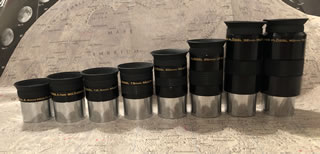Field of View
11.21 - Know that the field of view is the circle of sky visible through the eyepiece, measured in degrees or arcminWhat can you see right now with both your eyes? It’s not so much what you see as how much you can see. If you have healthy eyesight you can probably see about 120° in front and slightly to the sides, so basically a third of what is around you. This is your field of view.
It is what is in front of you that you see best. We look through a telescope and see a small are of sky and this is the field of view we refer to in astronomy. It’s usually abbreviated to FOV.
An eyepiece will let us see more of less of the sky. A wide FOV lets us see more. This is useful if we want to look at a particular constellation. A smaller FOV covers a smaller area so we might want to look at some of the Moon rather than all of it. The eyepiece will also let us magnify the image. We will come to that later.
There are two types of FOV; apparent and real.
My 26mm eyepiece has an apparent FOV of 52°. This is the apparent FOV as it’s not connected to telescope yet.
True FOV is when it is attached to a telescope. How do we figure out what this is then? With sums…
True FOV = Apparent FOV / Magnification
So we take 52 and divide it by the magnification. For which we need another formula (sorry about this).
Magnification = Telescope Focal Length / Eyepiece Focal Length
I know my telescope’s focal length is 1470mm (as it says next to the lens) and divide that by 26 = 56 magnification.
True FOV = Apparent FOV / Magnification so 52/56 = 0.9°.
A good reference when measuring the sky is the Moon. A full moon's diameter is half a degree or thirty arc minutes. With my 26m eyepiece I could see almost two moon diameters width of sky.
Links
Starizona Observing Theory
Highlands Astronomical Society Telescope Basics
Astronomy Tools Field of View Calculator





 | © All Rights Reserved |
| © All Rights Reserved |